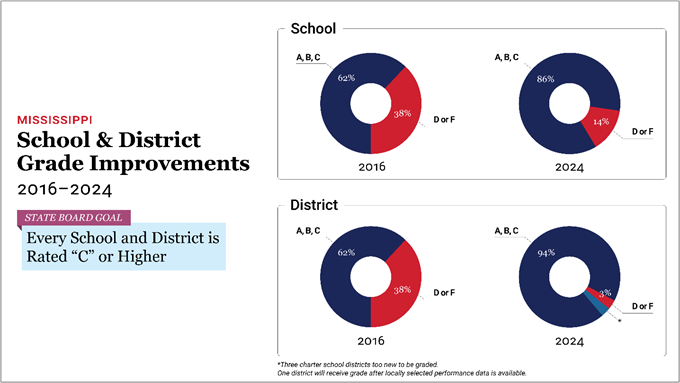MDE releases school and district accountability grades for 2023-24 school year


NEWS RELEASE
For Immediate Release: Sept. 17, 2024

MDE releases school and district accountability grades for 2023-24 school year
JACKSON, Miss. – The Mississippi Department of Education (MDE) released accountability grades for the 2023-24 school year, which show 85.7% of schools and 93.9% of districts earned a grade of C or higher.
The largest-ever share of Mississippi districts are now rated A, B or C. In 2016, the Mississippi State Board of Education set a goal that all schools and districts be rated C or higher. At that time, the percentage of schools and districts meeting this goal were both 62%.
Statewide student assessment data make up a large part of accountability grades. In 2023-24, the overall percentage of students scoring proficient and advanced reached an all-time high in mathematics, English Language Arts (ELA) and science.
“I am incredibly proud of our students, teachers and school leaders for their academic achievements in the 2023-24 school year,” said Dr. Lance Evans, state superintendent of education. “This year’s school and district grades are a testament to the quality and success of Mississippi public schools. I am confident we will continue to build upon this success to make sure every Mississippi public school graduate is prepared for a successful future.”
Mississippi is recognized as a national leader in education because over the past decade, students have made faster progress than nearly every other state. Several factors contributed to the steady rise in student achievement including the implementation of higher academic standards and statewide support to teachers to help students reach higher standards. Other factors include the effective implementation of laws and policies that developed or strengthened early childhood education, literacy instruction, school and district accountability, and advanced learning opportunities for high school students.
Since 2013, Mississippi’s national Quality Counts ranking for K-12 achievement improved from 50th to 35th, and the state’s overall education grade improved from F to C- (the nation’s grade is C). In 2024, the Annie E. Casey Foundation’s KIDS COUNT® Data Book ranked Mississippi 30th in the nation for education, the state’s highest-ever ranking.
Mississippi’s accountability grades help teachers, school leaders, parents and communities know how well their local schools and districts are serving their students. The components of the state’s accountability system are based on state and federal law and State Board policy. They include:
- Student proficiency and growth rates in ELA and Mathematics in grades 3-8
- Growth of the lowest performing 25% of students in ELA and Mathematics
- Science proficiency in grades 5 and 8
- English Learner progress toward becoming proficient in the English language
- Performance on the ACT and high school Algebra I, English II, Biology and U.S. History assessments
- Student participation and performance in advanced coursework such as Advanced Placement, career and technical education programs and dual credit/dual enrollment courses
- Four-year graduation rate
School and district achievements in 2023-24 extend to all districts under state leadership because of poor academic performance or a state of emergency. All four state-led districts have steadily improved under state leadership:
- Holmes County Consolidated School District: Improved to a B grade this year, after maintaining a C for two consecutive years. The district was rated F when it was taken over in 2021.
- Noxubee County School District: Maintained its C grade from 2023, improving upon its D rating in 2022. The district earned an F every year from 2016 to 2021.
- Achievement School District (ASD): The Humphreys County portion of the ASD improved its grade to a C, improving upon its D grade in 2023 and F in 2022. The Yazoo City portion of the ASD improved to a C from an F in 2023.
“The progress of our state-led districts proves what is possible when educators raise expectations, focus intensely on high-quality instruction and provide strong leadership, “Evans said. “Students are achieving at higher levels because they are being challenged and supported to succeed.”
Resources:
Find all MDE news releases at mdek12.org/news.
###
SDGs, Targets, and Indicators
1. Which SDGs are addressed or connected to the issues highlighted in the article?
- SDG 4: Quality Education
The article primarily focuses on the release of school and district accountability grades, which are indicators of the quality of education provided. SDG 4 aims to ensure inclusive and equitable quality education and promote lifelong learning opportunities for all.
2. What specific targets under those SDGs can be identified based on the article’s content?
- Target 4.1: By 2030, ensure that all girls and boys complete free, equitable, and quality primary and secondary education leading to relevant and effective learning outcomes.
- Target 4.5: By 2030, eliminate gender disparities in education and ensure equal access to all levels of education and vocational training for the vulnerable, including persons with disabilities, indigenous peoples, and children in vulnerable situations.
- Target 4.7: By 2030, ensure that all learners acquire the knowledge and skills needed to promote sustainable development, including, among others, through education for sustainable development and sustainable lifestyles, human rights, gender equality, promotion of a culture of peace and non-violence, global citizenship, and appreciation of cultural diversity and of culture’s contribution to sustainable development.
The article mentions the overall percentage of students scoring proficient and advanced in mathematics, English Language Arts (ELA), and science, indicating progress towards achieving learning outcomes (Target 4.1). It also highlights the improvement in education rankings and grades, suggesting efforts to eliminate disparities and improve access to quality education (Target 4.5). Additionally, the article mentions the implementation of higher academic standards and support for teachers, indicating a focus on equipping learners with the knowledge and skills needed for sustainable development (Target 4.7).
3. Are there any indicators mentioned or implied in the article that can be used to measure progress towards the identified targets?
- Student proficiency and growth rates in ELA and Mathematics in grades 3-8
- Growth of the lowest performing 25% of students in ELA and Mathematics
- Science proficiency in grades 5 and 8
- English Learner progress toward becoming proficient in the English language
- Performance on the ACT and high school Algebra I, English II, Biology, and U.S. History assessments
- Student participation and performance in advanced coursework such as Advanced Placement, career and technical education programs, and dual credit/dual enrollment courses
- Four-year graduation rate
The article mentions several indicators used in the state’s accountability system to measure progress towards the identified targets. These indicators include student proficiency and growth rates in ELA and Mathematics, science proficiency, English Learner progress, performance on assessments, participation and performance in advanced coursework, and the four-year graduation rate.
Table: SDGs, Targets, and Indicators
| SDGs | Targets | Indicators |
|---|---|---|
| SDG 4: Quality Education | Target 4.1: By 2030, ensure that all girls and boys complete free, equitable, and quality primary and secondary education leading to relevant and effective learning outcomes. |
|
| SDG 4: Quality Education | Target 4.5: By 2030, eliminate gender disparities in education and ensure equal access to all levels of education and vocational training for the vulnerable, including persons with disabilities, indigenous peoples, and children in vulnerable situations. | No specific indicators mentioned in the article. |
| SDG 4: Quality Education | Target 4.7: By 2030, ensure that all learners acquire the knowledge and skills needed to promote sustainable development, including, among others, through education for sustainable development and sustainable lifestyles, human rights, gender equality, promotion of a culture of peace and non-violence, global citizenship, and appreciation of cultural diversity and of culture’s contribution to sustainable development. | No specific indicators mentioned in the article. |
Source: mdek12.org








